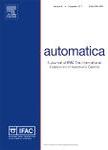版权所有:内蒙古大学图书馆 技术提供:维普资讯• 智图
内蒙古自治区呼和浩特市赛罕区大学西街235号 邮编: 010021

作者机构:Natl Taiwan Univ Dept Elect Engn Taipei Taiwan
出 版 物:《AUTOMATICA》 (自动学)
年 卷 期:2008年第44卷第11期
页 面:2716-2723页
核心收录:
学科分类:0711[理学-系统科学] 0808[工学-电气工程] 07[理学] 08[工学] 070105[理学-运筹学与控制论] 081101[工学-控制理论与控制工程] 0811[工学-控制科学与工程] 0701[理学-数学] 071101[理学-系统理论]
基 金:National Science Council of Taiwan [NSC94-2213-E-002-049] National Taiwan University [NTU 95ROO36-07]
主 题:Adaptive critic Approximate dynamic programming Mobile robot Neural networks
摘 要:Autonomous wheeled mobile robot (WMR) needs implementing velocity and path tracking control subject to complex dynamical constraints. Conventionally, this control design is obtained by analysis and synthesis or by domain expert to build control rules. This paper presents an adaptive critic motion control design, which enables WMR to autonomously generate the control ability by learning through trials. The design consists of an adaptive critic velocity control loop and a self-learning posture control loop. The neural networks in the velocity neuro-controller (VNC) are corrected with the dual heuristic programming (DHP) adaptive critic method. Designer simply expresses the control objective by specifying the primary utility function then VNC will attempt to fulfill it through incremental optimization. The posture neuro-controller (PNC) learns by approximating the specialized inverse velocity model of WMR so as to map planned positions to suitable velocity commands. Supervised drive supplies variant velocity commands for PNC and VNC to set up their neural weights. During autonomous drive, while PNC halts learning VNC keeps on correcting its neural weights to optimize the control performance. The proposed design is evaluated on an experimental WMR. The results show that the DHP adaptive critic design is a useful base of autonomous control. (C) 2008 Elsevier Ltd. All rights reserved.